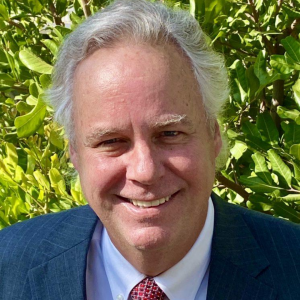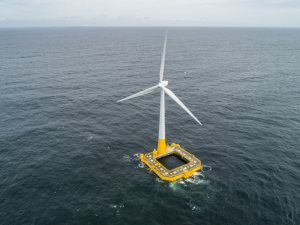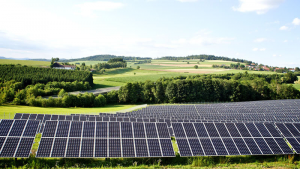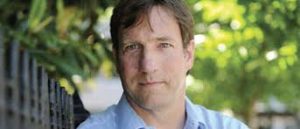November 10, 2020 – Volume 22, Issue 6
In This Issue
- Flanigan’s Eco-Logic: LBJ’s Climate Briefing
- Offshore Wind “Floaters” Poised
- Oregon is Now Coal-Free
- Green Hydrogen in the West
- Renewables Outpacing Coal and Nuclear
- Tidal Power Turbines
- Psychological Resilience, Biophilic Design
- The Swift and Fair Energy Transition
- EcoMotion Selected by Clean Power Alliance

Flanigan‘s Eco-Logic: LBJ’s Climate Briefing
Dr. David Orr of Oberlin College turned to history the other day in a UCLA presentation: He pointed to the reality that America has been aware of the imminent threat of climate change since the days of Lyndon B. Johnson, President of the United States from 1963 – 1969. It was during his presidency, that our federal government was first warned about the climate threat, that it could become an existential threat, potentially more devastating than nuclear weapons.
Orr drilled home this point: America has had more than a half century to make real changes and to protect our country from the threat of climate change, from the events that we are now experiencing in fire, flood, hurricane, and tornadic activity in increasing frequency and ferocity. Orr pried with force, “Why didn’t we act sooner?” “We could have reacted a long time ago.” “Now, this is a five-alarm fire.”
In terms of our atmosphere, we are passing a dysfunctional planet to our children. Does our freedom include the right to pollute the commons? Would America’s founding fathers have crafted a different constitution if they had had even a basic understanding of earth sciences? These insights from a UCLA Luskin and Burkle Center webinar: The National Security Imperative for Climate Action.
There is no question about the threat of climate change; the science is irrefutable, says U.S. Navy Admiral William Fallon, now retired after a career that literally spanned the globe. Speaking optimistically, we’re cutting a climate recovery pretty darn close: Keeping the average global temperature rise to 1.5 degree C above preindustrial levels is going to be monumental. We need to get there, and fast. We’ve already given up one degree. At two degrees “all bets are off” on what our life on Earth will look like. Three to four degrees of average global temperature rise would be intolerable, setting off a series of cascading and devastating events, floods, fires, food and water shortages, pandemics… economic and government collapse.
There are many reasons that the United States and other industrialized nations did not take action to protect our climate. There was no Plan B for the chance – now the reality – that the atmospheric scientists led by James Hansen were right. This is a threat of grotesque proportion. So, we are penalized for inaction… a half-century of inaction on a threat potentially greater than the wrath of the use of nuclear weaponry.
Phew…. Deep breaths. Darn it, this was indeed on the radar a long time ago. There is little point looking in the rear-view mirror. Instead, it’s time for accelerated action. It’s surge time for your own well-being and the well-being of the planet. Good news: The pace of clean energy development is impressive. The progress is palpable and contagious. That’s what EcoNet is all about… flagging and highlighting solutions, especially scalable solutions that make economic and environmental sense, fueling the invisible fires of eco-logic.
Quote of the Week
“There should be a price on carbon for the damage it is doing to the planet.”
U.S. Representative Ted Lieu
33rd District, California
Offshore Wind “Floaters” Poised

Offshore Wind “Floaters”
Walter Musial, a principal engineer at the National Renewable Energy Laboratory (NREL) expects that offshore wind – using floating wind turbines known as “floaters” – will be cost-competitive with fixed-bottom models by 2024. This is thanks in part to the work being done to reduce the barriers to offshore wind production. One means to reduce costs and streamline development is through the development of a robust port infrastructure where the turbines can be assembled then towed out to sea. Once towed to their locations, the “floaters” are then be held in place by mooring lines attached to anchors in deep waters.
Musial notes that 80% of the world’s offshore waters suitable for wind turbines near major population centers are in deep water. Thus floating turbines have huge application. Floaters are being developed in the United States by researchers at the University of Maine’s Advanced Structures and Composites Center. There, researchers experimented with a scaled-down wind turbine (10% in size) and placed it on concrete floats. In 2013, it became the first floatable wind turbine to feed electricity into the U.S. power grid. Maine sees huge potential for offshore wind: Maine’s offshore/floatable wind potential is 36 times the state’s electrical demand.
The U.S. pioneer of floating wind turbines on the West Coast is Alla Weinstein, now based in Seattle. Years ago, she proposed a floating wind farm with up to 100 turbines offshore in Morro Bay in Central California. While she found “tepid” support for her idea, Weinstein did find investors who financed a demonstration floater project off Portugal that did begin to generate power in 2011. Weinstein went on to build two more floaters in Portugal, and then another off the coast of Scotland.
In 2018, Weinstein submitted an unsolicited proposal to the California Energy Commission for offshore wind. By then, some 800 GW of offshore wind potential had been identified for California. Her work raised awareness of the cost effectiveness of offshore wind, and the viability of floating turbines. Her work also resulted in the U.S. Interior Department opening up 1,200 square miles of ocean for offshore wind leases. Meanwhile Dutch engineers are considering using electrolysis of water to create green hydrogen as a strategy to shore up the off-peak value of offshore wind.
Oregon is Now Coal-Free

In mid-October Portland General Electric (PGE) announced that it had permanently closed its Boardman plant, the last of Oregon’s coal-fired capacity. An agreement was reached between PGE and other stakeholders in 2010 to retire the plant 20 years ahead of schedule. Thus the utility and its partner Idaho Power, that owned 10% of the plant, have been planning on the closure for years. The 550 MW plant was the single largest source of greenhouse gases in Oregon.
While not a one-for-one replacement, PGE is investing in 300 MW of wind and purchasing the output of 50 MW of solar augmented with 30 MW of storage from NextEra from a location near the shuttered Boardman plant in Morrow County. This transition from coal to renewables speaks to public policy but also the low-cost of renewables.
The International Energy Agency reports that for the first time in history, solar is cheaper than fossil fuels for power generation. On average, solar is now the cheapest form of electricity for utilities to build. The report flags the regional cost of capital as an important determinant of solar viability, 2.6 – 5% interest rates for solar in Europe and the United States, 4.4 – 5.5 % in China, and 8.8 – 10% in India. As investors are confident in the technology and regional stability, lower interest rates will drop and drive further solar development.
Green Hydrogen in the West

The last issue of EcoNet reported on green hydrogen and three specific applications… namely its use in planes, trucks, and mining. I thanked the Green Hydrogen Coalition for expanding my brain. Now a follow-up webinar called the Western Case for Green Hydrogen.
It began with a poll. Attendees were asked to note their primary interest in green hydrogen: Energy resilience? Decarbonizing natural gas? Seasonal storage? Transportation fuels? The result: About an even split among these potentials, underscoring the breadth of applications for, and interests in, green hydrogen.
Impressed I was by one single notion: That Utah’s salt caverns could become the western region’s centralized energy storage site. A study commissioned by Mitsubishi Power, and completed by Magnum Energy, found that one salt cavern explored could hold 150 GWh of green hydrogen storage. That’s 100 times the aggregate amount of storage throughout the United States today. Utah can cost effectively serve the region in the storage and delivery of green hydrogen, as well as renewable electricity.
I learn a new word, a German word: dunkelflaute. It refers to the fear, or angst, of having inadequate sunshine or wind to maintain a viable supply of renewable energy. Lost a bit in translation, it speaks to being in a “dark lull” and the anxiety of it all. Dunkelflaute flags the enormous challenge of fully integrating renewables into the grid and getting to 100%. How can we ride through “short periods” of up to 60 minutes without generation (when there’s no sun or wind); “medium periods” that last for a few hours to several days, and “long periods” that can be up to two weeks in cases of very unfavorable, and unusual weather. Like insurance policies of any kind, we need to ensure enough power in the worst-case scenario. That spells lots of energy storage.
California is the leading U.S. energy storage market. Most of the capacity in place to date is 4-hour storage, much used for peak clipping. Now we have a new acronym: LDES for Long Duration Energy Storage… defined as storage with 6+ hours of energy. The California shift to a renewable future has already experienced costly curtailments of renewable energy systems… when the sun is shining, the wind is blowing, but the grid can’t take that much capacity. These are the best times to electrolyze water using this “excess power” and to create green hydrogen, storing power in the form of hydrogen for later use. Hydrogen can then be called upon to respond to the duck curve by fueling carbon-free peaking capacity, meeting the large ramps in utilities’ net load curve as the sun goes down.
A final webinar question: What is the biggest barrier to hydrogen in the west? Many consider hydrogen an energy carrier. Its answer struck me: Getting people to recognize that green hydrogen is a form of energy storage, just like batteries. Furthermore, planning decisions ought not be based on lowest cost form of storage, but highest value storage. Someone who wants the lowest cost watch gets a Timex. Someone who wants to maximize the value of a time piece gets an Apple watch with considerable functionality. Like the Apple watch, hydrogen brings a breadth of applications and benefits. It can be used to decarbonize not only the power sector, but industry, heating, and transportation. And the West is leading the charge.
Renewables Outpacing Coal and Nuclear

The Year 2020 will always be remembered as a strange buy ambien from mexico year, but there are glimmers of light: Ken Bossong’s Sun Day Campaign reports that Energy Information Administration (EIA) data shows that for the first eight months of the year – through August — renewables produced more power than coal-fired electricity in 27 states. Similarly, renewables outpaced nuclear in 29 states for the first two-thirds of the year. Notably, renewables produced more than either coal or nuclear in three of the nation’s four largest states: California New York, and Texas.
Including distributed solar, renewables accounted for 20.8% of the nation’s electrical generation during the first two thirds of 2020 compared to 19.4% from nuclear and 18.4% from coal. The six New England states have become a nearly coal-free zone.
EIA data on 2019 shows that it was a banner year for renewables. In 2019, consumption of renewable energy in the United States grew for the fourth year in a row, reaching a record 11.5 quadrillion BTU, or 11% of total national energy use. The EIA converts sources of energy to common units… converting gallons of biofuels and kilowatt hours of green electricity to a fossil fuel equivalence, especially important given noncombustible renewables such as wind, hydro, solar, and geothermal.
Wind now accounts for 24% of U.S. renewable energy consumption. It surpassed hydro (22%) in 2019 to be the most consumed source of renewable energy. Wood, waste energy, and biomass waste from landfills accounted for 24% of U.S. renewable energy use. Industries, for example, use wood and waste to generate electric for heat and the manufacture of goods. About 2% or U.S. households used wood as their primary source of heat in 2019. Solar’s contribution to total energy consumption is at 9% and recorded the largest growth among the renewables.
Focusing solely on electricity, for the first eight months of the year, renewable forms of energy provided 63.3% of all new U.S., utility-scale capacity, 10,445 MW of the 16,499 MW total. Natural gas capacity accounted for 36.5%, with very small contributions by coal (20 MW) and “other sources” (5 MW). This past summer, all of the 2,781 MW of new generating capacity added during June, July, and August was provided by solar (1,448 MW), wind (1,309 MW), and hydropower (24 MW).
Tidal Power Turbines

Source: Verdant Power
New York City’s East River is now home to the first U.S. licensed tidal power turbines. As the tide comes in, the turbines generate power. As the tides go out, the turbines pivot and generate power. Three turbines submerged in the East River near Roosevelt Island make up the Roosevelt Island Tidal Energy (RITE) project. Power from the submerged turbines will feed into the Consolidated Edison grid. Verdant Power installed the turbines, its fifth-generation tidal power system and one that uses its TriFrame mounting system. The company claims that its design is scalable for larger sizes in deeper and faster tidal straits.
According to experts, Verdant has been, “hammering away” at this East River project since 2002. In 2012, it achieved the major milestone of getting its commercial pilot license from the Federal Energy Regulatory Commission to operate submerged turbines. It initially had problems with strong river currents, but the company believes that new blades made of plastic and fiberglass will be effective. The pilot program in the east channel of the East River has been supported by NYSERDA and the USDOE plus private investors. For Verdant and New York’s green power community, popping this “fifth-generation” model into the East River is a big deal.
Psychological Resilience, Biophilic Design

Bill Browning’s Terrapin Green blog on biophilic design continues to open horizons for me. This month, he writes about psychological resilience. Psychological resilience is the ability to mentally or emotionally cope with a crisis or to return to a pre-crisis status quickly. He focuses on the need to rebuild after wildfires – notably in Malibu, California — have mercilessly wiped out homes and communities. How can residents return to these sites and feel safe, without the negative effects of stressors?
Bill and I were colleagues at Rocky Mountain Institute some years ago. He and his firm, Terrapin Green, have been focused on the rebuild in Malibu after the devastating Woolsey fire that took 97,000 acres and 1,643 homes and buildings in 2018. Bill states that the job then was to affordably build energy-efficient and disaster-resilient homes. And now, upon reflection he writes that the challenge really is greater… Homes must be designed that also address psychological resilience.
Bill’s experience is that a primary hurdle of rebuilders – those trying to get back to normal — is the psychological trauma. Some have Post-Traumatic Stress Disorder (PTSD) as a result of losing their homes and all their belongings, in cases loved ones. Thus, their challenge is not just to physically rebuild, but to build back their own resilience. Some of this is done with counselling; the Malibu Foundation has been offering counselling services to rebuilders there.
Bill says that his biophilic design specialty – increasing the connectivity to the natural environment — can be part of the path to psychological resilience. Finding a way to form a reconnection to place and one’s surroundings can play a powerful part of the healing process. Biophilic design might include the selection of grounding, natural materials. It might encompass landscaping that creates a savanna-like setting around the house. It might manifest in designing spaces that offer emotional refuge… typically when one’s back is protected and there is cover overhead. People like nooks; people like to cocoon at home.
Bill closes by writing that biophilic design can support the psychological wellbeing of people dealing the post-disaster stress. In this period of pandemic, psychological resilience may well be important for us all.
The Swift and Fair Energy Transition

The role of Community Choice Aggregators has quickly expanded from a green commodity buyer… to social benefit companies providing energy resiliency and equitable jobs in the communities they serve. Now a global perspective provided by a Rocky Mountain Institute webinar moderated by James Newcombe – “Aligning Toward a Renewable Economy for a Swift and Fair Energy Transition” — put the plight of equitable jobs and opportunities in the clean energy transition in the fore.
Newcombe welcomes all and lays it on the line: There has been and continues to be a lingering perception that a clean energy economy will burden global economies. But no. He sites data that shows far more jobs in clean energy. They are growing fast and creating sustained jobs in our society. The World Energy Outlook of the International Energy Agency (IEA) presents a sustainable development scenario – “nearly Paris compliant” – that projects that there could be 27 million clean energy jobs in the next three years, while preventing 12 million deaths related to asthma and other respiratory diseases exacerbated by fossil-fuel emissions.
Another study, by IRENA – the International Renewable Energy Agency – projects that 2 – 7 million jobs will be lost in the fossil fuel industries by 2030, and 38 – 60 million new jobs in the clean energy. There are already three times as many clean energy jobs in the United States as there are fossil fuel jobs. Panelist and RMI Principal Jacob Corvidae posited a discussion with his son: “So, do you want a job in the fading fossil fuel industry, or the booming solar industry?” The choice is pretty obvious.
The pandemic has hit the fossil fuel industry really hard, so hard that it may never recover. A Deloitte study notes that of the 107,000 oil and gas jobs lost in the pandemic, as many as 70% may be permanently lost. Newcombe noted that the year 2019 may be oil and gas’s peak year. Meanwhile, the clean energy industry will rebound quickly. The challenge and opportunity is for the public and private sectors to come together to strategically chart a sound clean energy course. A big part of this involves jobs and equity.
Corvidae discussed jobs in inner cities and creating a just transition to a clean energy economy. How can small, disadvantaged businesses participate? Corvidae said that it will take policies to make it happen. In Boston, RMI is working in collaboration with the Emerald Cities Collective to promote means for minority-owned contractors to access the pipeline of public-sector work… providing normally underrepresented companies with good paying jobs. This is “doing development differently.” He talked about Detroit and its Community Benefit Agreements… creating opportunities and addressing the structural injustices. New York’s Climate Leadership and Community Protection Act requires that 35% of its funds are targeted into disadvantaged communities.
Panelist Sharon Burrow Leslie began by making it clear that the post-pandemic recovery will need to be in both social and environmental balance. Due to the pandemic, a half billion jobs have been lost around the world. There is both a climate and health emergency at hand. Furthermore, Leslie noted that there has been an erosion of trust in democracy. A recent study shows that less than 45% of young people trust democracy. Given social unrest, Leslie said that we need to rebuild the public’s trust through transparency and accountability. There needs to be a just transition to our clean energy future. The European Union has plans for recovery that have a social pillar based on a green new deal and cutting supply-chain exploitation.
Martin Luther King was quoted, that we need leaders not in love with money, but in love with justice. If the recovery is just about money, we fail the planet, we can’t have justice. Yet there has been an explosion of global monopoly power and profits… during the pandemic. Just as there have been huge corporate gains, and unconditional public subsidies of corporations, there has been marked social unrest and Leslie predicts that there will be more unless justice is served.
The times are indeed unprecedented, but they are predictable. The pandemic was predictable; so are the effects of climate change. So is the civil unrest. Now we need policies to support a just clean energy future: Yes, we need zero net energy. We also need zero net job loss. We cannot rebuild the global economy if people don’t have jobs and income. Every job lost must be replaced with new jobs.
How can there be a just transition to a clean energy economy? Capitalism does have the brilliant merit of self-organizing. But it has inherent flaws. There needs to be means to address justice and equity within a capitalist society and in the transition to a sustainable future. Externalities can be no longer. This RMI webinar made clear that we have the challenge and opportunity to meet both our social and climate objectives together. Jobs are a fundamental aspect of the recovery we all crave. We redefine the rules; we cannot prescribe the status quo.
EcoMotion Selected by Clean Power Alliance
EcoMotion is pleased to announce that our team was selected by the Clean Power Alliance — the largest community choice aggregator in the nation — to develop 32 microgrids in its service territory in Los Angeles and Ventura counties. The CPA Board of Directors approved the selection of EcoMotion at its November 5 meeting for this cutting-edge and most timely scope of work.
The CPA-funded solar + storage microgrid projects will serve each of its member agencies with energy resiliency, ever-more-important as California’s grid is threatened by the ravages of climate change. EcoMotion will start by working with member cities (and unincorporated county areas) to identify suitable sites for energy resilience and maximizing community benefit.
